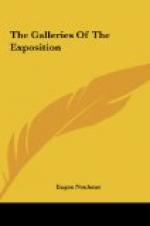Gallery 75.
Sargent.
A small adjoining gallery is given entirely over to a few Sargents which are quite sufficient to maintain this great stylist, whom many believe the towering giant of the profession. One thing is evident from this work — that for surety of touch and technical directness he stands practically alone, though he does not possess the deliberate ease in which Duveneck rejoices. Sargent’s “John Hay” and “Henry James” are absolutely exhaustive as character studies. His “Nubian Girl”, however, is woody, no matter how interesting in posture. In nothing does he disclose his marvelous precision of technique so completely as in some of the outdoor studies, like the “Syrian Goats” and the “Spanish Stable”. There is nothing like them in the exhibition anywhere, and these two things alone make up for what is really not a comprehensive display of one of the greatest of modern living painters. However, a man whose standard of excellence is relatively very even does not need a large representation.
Gallery 90.
Keith.
In two other small galleries of similar size three California painters have their inning. While all these are of different caliber, they have something in common which ties them closely together. It seems peculiar that a country famed for its sunshine should produce men like Keith, Mathews,, and McComas, who surely do reflect a rather somber atmosphere, in a type of work which must be called tonal and arbitrary rather than naturalistic.
Keith’s collection, with the mass of modern landscape all around, and even compared with other followers of the Barbizon school, seems somewhat somber, as compared with the vital buoyancy of Redfield and others of Redfield’s type. His range of idealistic landscape subjects is intimate, but not characterized by the stirring suggestion of outdoors which Inness, Wyant, and others of his school possess. Keith’s marvelous dexterity of brushwork really constitutes his chief claim upon fame, and some of his best things are gems in easy-flowing methods of painting which the best men of the Barbizon school seldom approached. Keith must not be looked upon as a painter of nature nor even an interpreter of nature. He used landscapes simply to express an ever-changing variety of personal emotion. His attitude toward nature in his later work was of the most distant kind, although his early career was that of the most painstaking searcher for physical truthfulness.




